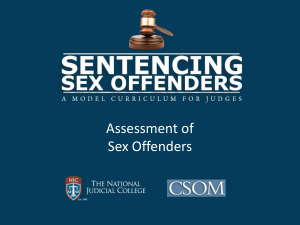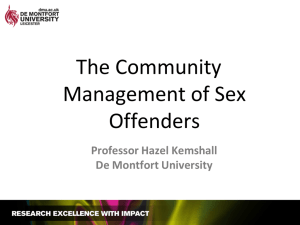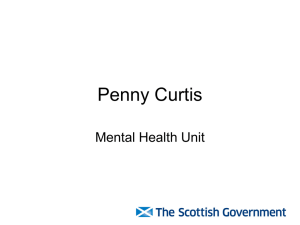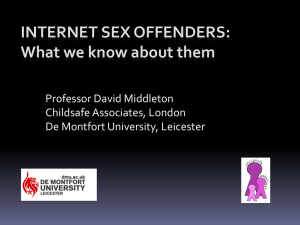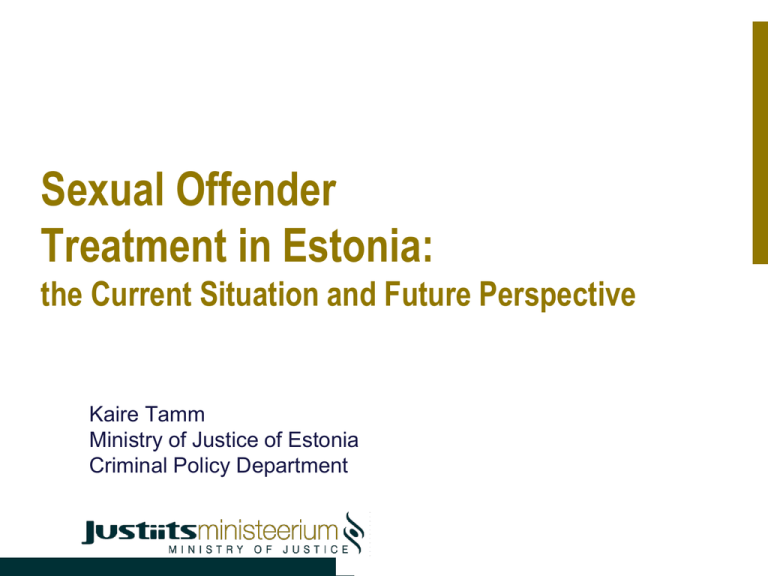
Sexual Offender
Treatment in Estonia:
the Current Situation and Future Perspective
Kaire Tamm
Ministry of Justice of Estonia
Criminal Policy Department
Summary of the Current Situation
Changes in legislation
• More strict punishments (imprisonment rate was raised) for
sexual offences committed against children (in 2006).
• Restrictions concerning working with children for convicted
sexual offenders (in 2007, amendments planned in 2011).
• The amendments, which enable courts to apply postsentence detention and post–sentence supervision of conduct
in 2009).
• The amendments, which made grooming punishable (in
2010).
Summary of the Current Situation
Changes in Policy
• The Convention on the Protection of Children against Sexual
Exploitation and Sexual Abuse signed in 2009.
• Guidelines for Development of Criminal Policy until 2018
approved in 2010: the use of alternative punishments shall be
promoted (treatment, conciliation, etc.).
• Development Plan for Reducing Violence for years 2010–
2014 approved by Government in 2010: to prevent sexual
violence against children the treatment and rehabilitation
possibilities for abusers shall be developed.
Summary of the Current Situation
Sexual offenders in prison and probation, 2011
• Every year approximately 50-60 persons are convicted in
sexual offences.
• Most sex offenders are located in one prison – until 2010 in
Murru prison (will be closed) and since 2011 in Tartu prison.
Convicted sexual
offenders in prison
01/2011
Convicted sexual
offenders in probation
01/2011
123
77
Summary of the Current Situation
Risk assessment
• General risk assessment instrument used in Estonia doesn´t
take into account the specificities of sexual offenders.
• Since 2009 RiskMatrix 2000 partially used to assess static
risk factors of convicted sexual offenders (in case of release
on parole).
• So far no dynamic risk factors assessment (Stable 2007) of
convicted sexual offenders, but will be in immediate futures.
Summary of the Current Situation
Rehabilitation and treatment
• In 2007 sex offender rehabilitation program based on relapse
prevention model was established: trainers from Holland,
training was in Estonia (almost 30 participants).
• Program is meant for male adults, so far approximately 100
participants.
• So far no evaluation of program implementation and
effectiveness.
• No approach for minors with sexually delinquent behaviour,
who should be dealt primarily outside the punishment system.
• No standards or guidelines for the treatment of sexual
offenders outside the prison system.
• In 2010 study visits to Nordic countries and UK.
Recidivism study
• Carried out in 2009 (based on 2007 database); prison data
will be updated annually. Recidivism indicator – interrogation
as suspects in new criminal offences.
• The one-year overall recidivism rate was lowest in the case
of terminated proceedings (18%) and highest in the case
people released from prison (40%).
Figure 1. The one-year recidivism rate in the case people
released from prison
Summary of the Future Perspectives
• The standard for the treatment of sexual offenders will be
prepared by experts (in and outside prison system).
• Need for staff training (for program implementation) and
specialized psychiatrist in Tartu prison to set up treatment
system.
• Sex offender rehabilitation program development and
assessment.
• Risk assessment development (Acute dynamic risk factors
assessment).
• Law amendments to enable assign treatment (if necessary
also in combination with other treatment options) as part of
punishment.
Conclusions
• Sex offender treatment receives a lot of attention in national
strategies: includes measures for victim support and abuser
treatment as well.
• Currently Estonia aims to prevent sexual offenders recidivism
mainly by sex offender rehabilitation program (therapy)
carried out in probation and prisons (until 2010 in Murru and
since 2011 in Tartu prison).
• Risk assessment development.
• Plan making proposal to enable treatment as a part of
sanctions for convicted sexual offenders.
• Better cooperation needed between prison and health-care
system (treatment options outside prison system).
Thank you for your attention
Kaire Tamm
Adviser in Analyses Division
Criminal Policy Department
Ministry of Justice of Estonia
www.just.ee
Kaire.Tamm@just.ee





